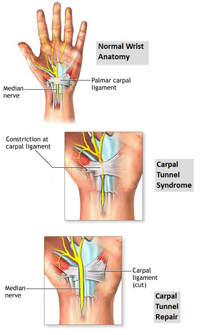Carpal Tunnel Syndrome

Carpal tunnel syndrome occurs when the median nerve, which runs from the forearm into the palm becomes pressed at the wrist. The median nerve controls sensations to the palm side of the thumb and fingers, as well as impulses to some small muscles in the hand that allow the fingers and thumb to move. The carpal tunnel - a narrow, rigid passageway of ligament and bones at the base of the hand houses the median nerve and tendons. Sometimes, thickening of irritated tendons narrows the tunnel and causes the median nerve to be compressed. The result may be pain, weakness, or numbness in the hand and wrist, radiating up the arm. Symptoms usually start gradually, with frequent burning, tingling, or itching numbness in the palm of the hand and the fingers, especially the thumb and the index and middle fingers.
Treatment
Medications used in the treatment of carpal tunnel syndrome include nonsteroidal anti-inflammatory drugs. Corticosteroid injections, given into the carpal tunnel area, may relieve symptoms for a period of time. Further Carpal tunnel release is a surgical procedure that cuts into the ligament that is pressing on the nerve. Surgery is successful most of the time, but it depends on how long the nerve compression has been occurring and its severity.
 Alzheimer's Disease
Alzheimer's Disease